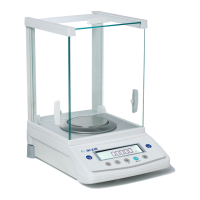
Do you have a question about the Aczet CY 304C and is the answer not in the manual?
Safety precautions for using the balance, including electrical safety and handling.
Guidelines for storing and shipping the balance to prevent damage.
Instructions for unpacking and checking the balance for damage.
Diagram and labels for the layout of analytical and carat balances.
Diagram and labels for the layout of precision balances with draft shield.
Instructions for setting up the balance with a wind shield chamber.
Guidance on selecting the best location for balance accuracy and stability.
Factors to avoid when choosing a location for the balance.
Recommended warm-up times for the balance to ensure accurate results.
Detailed explanation of each key and its function on the balance interface.
Describes how the balance enters and operates in standby mode.
Quick guide to basic operations using key presses and holds.
Step-by-step procedure for performing a simple weighing.
Instructions for taring the balance before weighing samples.
How to change the displayed weight units on the balance.
Details on how printouts are generated in simple weighing mode.
Conditions requiring external calibration of the balance.
Step-by-step guide to perform external calibration.
Conditions requiring internal calibration of the balance.
Step-by-step guide to perform internal calibration.
Steps to perform a calibration test to check accuracy.
Steps to perform a calibration test with actual calibration.
Explanation of key functions for navigating the user menu.
Details on selecting weighing mode options.
How to preselect functions for quick access in weighing mode.
Overview of special applications and functions available.
How to select and use different weight units.
How to adjust the stability filter for ambient conditions.
Options for selecting external or internal calibration.
Options for selecting calibration test modes.
How to enable or disable the auto zero tracking feature.
How to set the data transmission rate for printing.
Setting the parity for transmitted data.
Selecting the stop bit for transmitted data.
How to select the data transfer mode.
Setting the GLP compliance for print formats.
Configuring the automatic standby feature.
How to reset balance settings to factory defaults.
Procedure for counting pieces using the balance.
Setting a custom reference number for piece counting.
Entering a known piece weight directly for counting.
Improving piece counting accuracy by updating settings.
Steps to perform percent weighing.
Setting a custom reference percentage for weighing.
Calculating loss content of a sample.
Calculating the residue content of a sample.
Determining moisture content based on dry weight.
Determining dry content based on wet weight.
Using percent weighing for differential analysis.
Steps to set up and use custom units for weighing.
Setting the conversion factor for custom units.
Setting the accuracy for custom units.
Setting the least significant digit for custom units.
Procedure for manual animal weighing.
Procedure for automatic animal weighing.
Steps for manual formulation weighing.
Steps for automatic formulation weighing.
Steps to perform check weighing.
Setting target and tolerance values for check weighing.
How results are displayed for low and high range check weighing.
Procedure for manual totalization of weights.
Procedure for automatic totalization of weights.
Steps to determine density.
Setting the temperature for density determination.
Selecting the liquid type for density determination.
Selecting the mode for density determination.
Detailed procedure for density determination.
Steps to calibrate the pipette.
Setting the number of calibration cycles.
Setting the temperature for pipette calibration.
Setting the pressure for pipette calibration.
Setting initial, half, and full volumes for calibration.
The actual calibration process for pipettes.
Steps to use the statistics function.
How to view and interpret statistical data.
How to delete stored statistical data.
Explanation of key functions for parameter settings.
Settings for identification and lot identification numbers.
Settings for time and date.
Settings for automatic calibration.
How to set the time on the balance.
How to set the date on the balance.
How to set the identification number.
How to set the lot identification number.
Configuring auto calibration based on time.
Configuring auto calibration based on temperature.
Configuring calibration to occur on power on.
Steps to configure Windows accessibility options for communication.
Configuring unit settings for Windows communication.
Configuring separator settings for Windows communication.
Describes parameters included in ISO/GLP compliant printouts.
Parameters included in the GLP header.
Parameters included in the GLP footer.
How to set print options for GLP compliance.
Purpose of the data interface for connecting to computers.
Technical features of the data interface.
Default factory settings for the data interface.
Explanation of the 26-character output format.
Structure for sending commands to the balance.
Specific commands that can be sent to the balance.
Diagram showing RS-232 cabling for connecting devices.
List of error codes, their causes, and solutions.
Information on regular servicing and service contracts.
Guidelines for performing repairs on the balance.
Instructions for cleaning the balance and its parts.
Specific instructions for cleaning stainless steel parts.
When the DC adapter's safe operation is no longer warranted.
Terms and conditions of the warranty.
Form for warranty registration.
Dimensional drawings for analytical balances with draft shield.
Dimensional drawings for carat balances with draft shield.
Dimensional drawings for top loading precision balances without draft shield.
Dimensional drawings for precision balances with draft shield.
Dimensional drawings for high capacity precision balances.
Dimensional drawings for high capacity precision balances with windshield.
Specifications for analytical balance models.
Specifications for analytical balance models.
Specifications for precision balance models.
Specifications for precision balance models.
Specifications for top loading precision balance models.
Specifications for top loading precision balance models.
Specifications for top loading precision balance models.
Specifications for high capacity precision balance models.
Specifications for high capacity precision balance models.
Specifications for carat balance models.
Specifications for carat balance models.
Optional statistical printer with date, time, and statistics.
Optional remote display unit.
Optional calibration weights for balance calibration.
Optional USB interface for connectivity.
Optional density kit for liquid analysis.
Optional anti-theft cable and lock.
Optional dust cover for the balance.